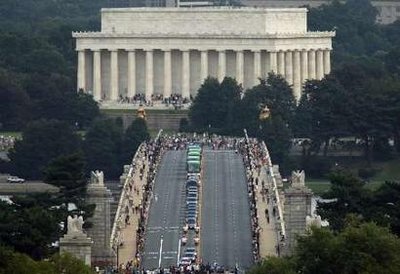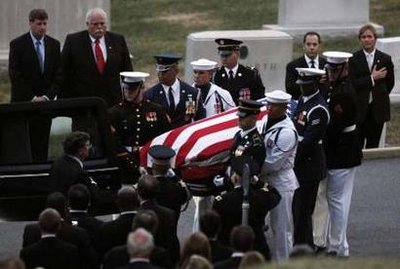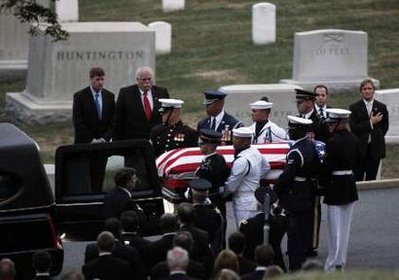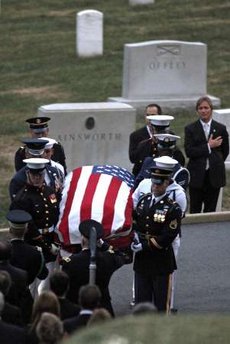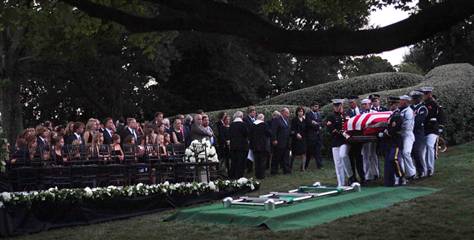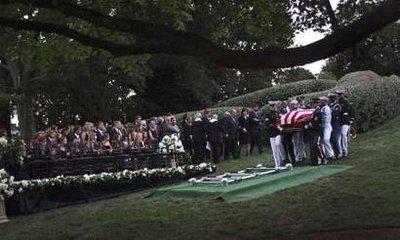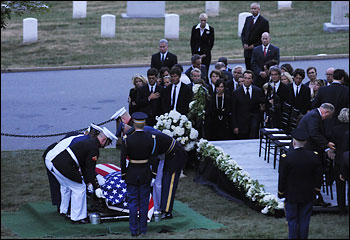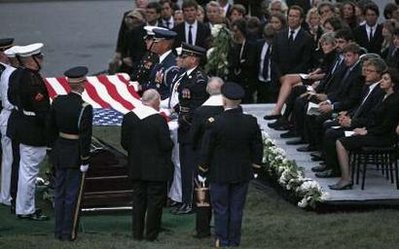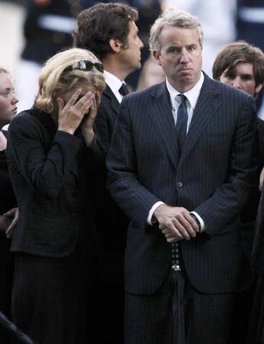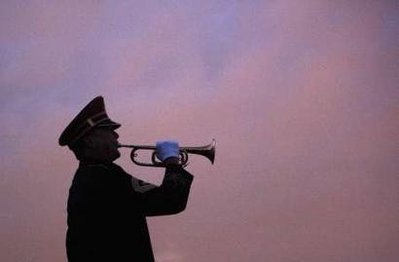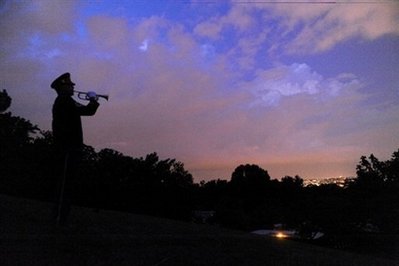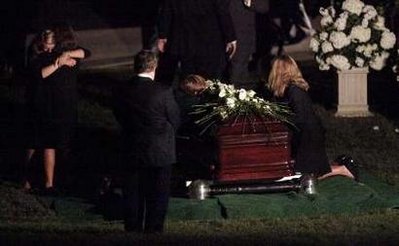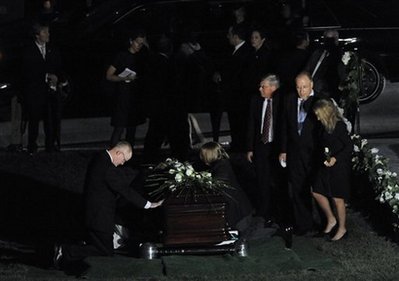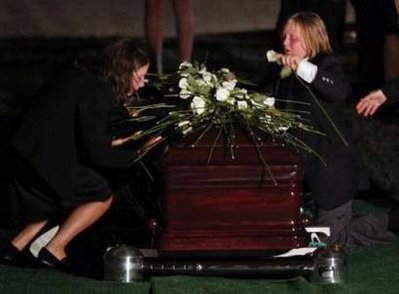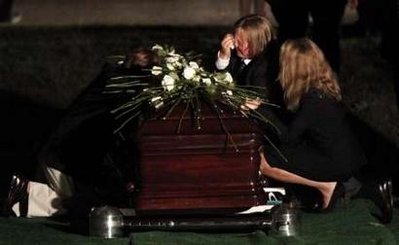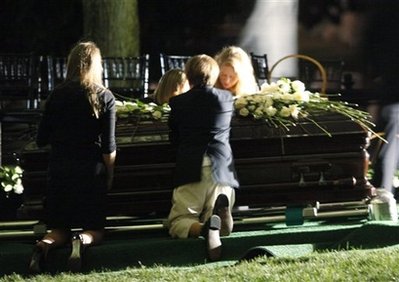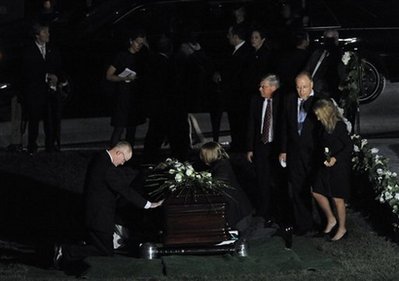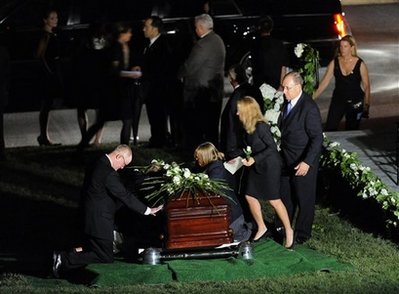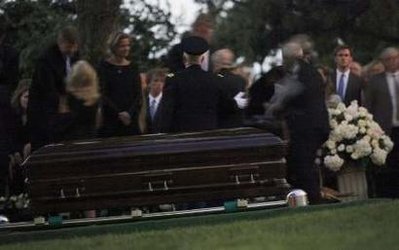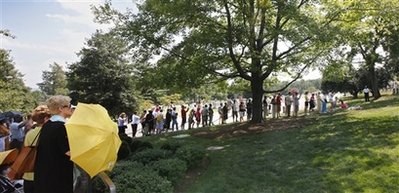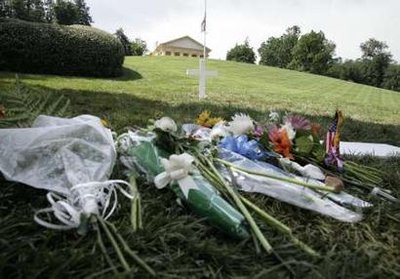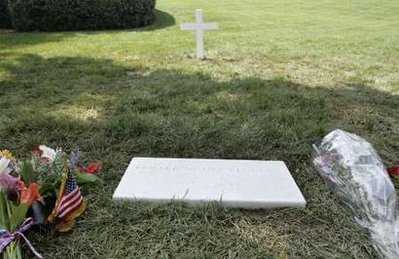Burial Information
Kennedy Burial Steeped in Military, Personal Symbolism
Office of the Secretary of Defense Public Affairs
Story by John Kruzel
28 August 2009
Twenty-six years ago, Senator Edward M. Kennedy received a dire letter from a member of his Massachusetts constituency.
A poor Boston woman with flagging health was pregnant with her first child. Unable to afford health care, her letter was a plea for the coverage she desperately needed. Kennedy personally responded.
“She might not have even had kids,” Army Sergeant John Kenney said of his mother. “I might not be here today if it wasn't for him.”
As Kenney narrates the circumstances surrounding the “high-risk” birth he survived, he crosses his arms and bears a tattoo with “Boston” scrawled in block letters across his right forearm. But tomorrow, the sergeant's ink homage will be obscured by the sleeves of his Army dress uniform, his hands covered with white gloves.
Kenney, a member of an elite team of military members, will lay his hometown hero's remains to rest at Arlington National Cemetery here.
“When I heard he was being buried down here, my first thought was: ‘I have to be on that team,'” he said.
Despite any sense of personal connection or the prominence associated with the senator, Kenney and other members of the “casket team” assigned to overseeing the senator's remains from Andrews Air Force Base, Maryland, agree that their focus on their mission will be unwavering when duty calls.
This level of precision is customary throughout the military traditions will be evident throughout ceremonies honoring Kennedy, as the services join the nation in bidding farewell to the “Lion of the Senate.”
Splashed on newspaper front pages across the country Aug. 28 were images of steadfast service member pall bearers leading Kennedy's flag-draped casket to a procession that departed August 27 from Hyannis Port, Massachusetts, where the senator succumbed to his battle with brain cancer August 25. The procession then traveled to Boston, where Kennedy will lie in repose until his funeral Mass and burial here.
Kennedy's coffin will arrive tomorrow afternoon at Andrews Air Force Base, where Kenney and the seven other members of the team will prepare the casket for a motorcade bound for Arlington National Cemetery. At the cemetery, a separate casket team and its commanding officer will assume responsibility. Teams are jointly composed of members of each military branch, with Army members hailing from the the 3rd Infantry Regiment, or “Old Guard.”
The senator's coffin will be enshrouded in a U.S. flag, with the blue field over his left shoulder. The custom began in the Napoleonic Wars of the late 18th and early 19th centuries, when a flag was used to cover the dead as they were taken from the battlefield on a caisson.
Kennedy's service in the Army and his tenure as an elected official made him eligible for burial at the nation's most hallowed military cemetery. But Kennedy's contribution to the U.S. military endured long after he left the Army.
The senator was a vocal champion of legislation such as the Goldwater-Nichols act, which vastly reorganized the armed forces as a joint structure, and of military pay reforms, which ushered in the most comprehensive reforms of the military and defense establishment since the end of World War II.
Graveside military honors will include the firing of three volleys each by seven servicemembers. This commonly is confused with an entirely separate honor, the 21-gun salute. But the number of individual gun firings in both honors evolved the same way. The three volleys came from an old battlefield custom. The two warring sides would cease hostilities to clear their dead from the battlefield, and the firing of three volleys meant that the dead had been properly cared for and the side was ready to resume the battle.
In keeping with tradition, an Army bugler will play “Taps,” which originated in the Civil War with the Army of the Potomac. Union Army Brigadier General Daniel Butterfield didn't like the bugle call that signaled soldiers in the camp to put out the lights and go to sleep, and worked out the melody of “Taps” with his brigade bugler, Private Oliver Wilcox Norton. The call later came into another use as a figurative call to the sleep of death for soldiers.
In a final gesture, the surviving members of Kennedy's family will receive the flag that draped the senator's coffin.
As with all military burials in which he's participated in the past two years, Kenney said he is striving to achieve technical perfection during the ceremony.
“We try to get it so the family says, ‘I'm so proud how they honored our loved one,'” he said. “We go into doing the same thing we do with every funeral, and that's to give them their last honors.”
But in a moment of introspection, Kenney revealed the personal symbolism underlying tomorrow's ceremony.
“It feels like it's come full circle,” he said. “He helped me get here, and I'm going to see him out.”
Kennedy's Gravesite Is Near Brothers
By Shailagh Murray
Courtesy of The Washington Post
Saturday, August 29, 2009
The scene at Arlington National Cemetery is simple, and the burial service that will begin momentarily will be brief and intimate, in contrast to the epic memorial service and funeral Mass of Friday night and earlier Saturday.
Senator Edward M. Kennedy's gravesite is on a slope, about 20 feet off Sheridan Drive, in Section 45 of the cemetery. It is exactly 100 feet from the site of his brother Robert F. Kennedy's grave, which now sits in the middle of a Kennedy grave arc, with the John F. Kennedy eternal flame at the far point.
Cemetery superintendent John C. Metzler Jr. said he was contacted by Kennedy staff a few weeks ago to discuss burial options, but no decisions were made until the day of the senator's death. He said he had accompanied Kennedy on many visits to his brothers' graves.
The grave was excavated at 7 a.m. Saturday. A small platform with two rows of chairs, seven in front and eight back, is positioned next to it. Mr. Metzler said workers broke an irrigation line while they were digging the hole.
The service is called the “Rite of Committal and Prayer of Commendation.” The thick program is printed on marbled parchment with black ink. The flowers lining the stage are white hydrangea and the larger arrangements at either end of the platform also include white roses. The grave site is located between two maple trees.
The new Kennedy markers will be identical to those for RFK: a glossy white oak cross at the head of the grave and a white marble foot marker. It will read:
” Edward Moore Kennedy”
“1932-2009”
According to Metzler the Kennedy markers are the only two simple white crosses at the cemetery, and Section 45 is one of the only areas where crosses are permitted. The headstones in the surrounding area of the section are of all shapes and sizes, including larger granite crosses, in contrast to the simple white stones that dominate here.
Presiding over the short service is Cardinal Theodore McCarrick, a good friend of the senator. McCarrick enlisted Kennedy and House GOP leader John Boehner to help raise money for D.C. Catholic schools, and the two also saw each other socially from time to time, according to Jim Manley, former Kennedy spokesman.
The “three volleys” in the middle of the service will be fired by seven riflemen, a traditonal military funeral ritual, and not to be confused with a 21-gun salute, which is reserved for presidents. The casket will be carried by eight members from all five service branches, plus a commanding officer, who belong to the “joint casket team.” The volleys will be fired by members of the U.S. Army, because Kennedy served two years in the Army after he was expelled from Harvard.
Just 15 family members will attend the service, including Vicki Kennedy, Ted Kennedy Jr., Kara Kennedy, Patrick Kennedy, Curran Raclin, Caroline Raclin, Jean Kennedy Smith, Ethel Kennedy, Kiki Kennedy, Kiley Kennedy, Teddy Kennedy III, Grace Allen, Max Allen, Doris Reggie, Judge Edmund Reggie.
Vice President Joseph R. Biden Jr. and Dr. Jill Biden also will attend.
Kennedy laid to rest at Arlington
By J. Taylor Rushing
Courtesy of The Hill
Posted: 08/29/09 09:55 PM
Senator Edward Kennedy was laid to rest Saturday evening at Arlington National Cemetery as the sun set on a day that began with a somber funeral service in Boston and included a final tribute at the U.S. Capitol.
A 25-minute burial held in growing darkness included military honors such as a volley of rifle fire and a playing of “Taps,” and an address by Cardinal Theodore McCarrick, archbishop emeritus of Washington and a longtime Kennedy friend. McCarrick read a letter Kennedy had sent Pope Benedict that President Obama had delivered personally in July. The letter asked the pope to pray for him as Kennedy approached the “next passage of life.”
Vice President Joe Biden and his wife, Jill, attended the service, along with Kennedy’s wife, Victoria, and eldest son, Edward Jr., and other members of the Kennedy family.
Kennedy died late Tuesday at 77 after a 15-month long battle with brain cancer. The senator served 47 years in the Senate, first winning election in 1962 to the seat formerly held by his brother, President John F. Kennedy. The senator was memorialized in a two-and-a-half-hour funeral service in Boston Saturday morning, then flown to Andrews Air Force Base and driven to the Capitol for a brief outdoor ceremony.
Four presidents, more than half of the U.S. Senate, and celebrities from film, sports and music attended his funeral. At the Capitol, more than a thousand senators, House members, congressional staff and ex-Kennedy aides waited patiently on the steps for a final viewing and to express their condolences to Victoria Kennedy and Kennedy's children.
Thousands of more people who had likely never met Kennedy lined the route to Arlington. Police estimated 4,000 people stood along Constitution Ave. as the motorcade traveled slowly through D.C. The procession was greet by the sounds of cheers, applause and shouted condolences from the crowd along the road.
Delays meant the burial service originally scheduled for 5:30 p.m. was instead held two and a half hours later. After the sun set, the only lighting came from the Robert E. Lee House above the hill and the headlights of cars from the funeral procession parked nearby. A constant ringing of cicadas created a background to the prayers and final remembrances. Rain, although forecast, did not interrupt the ceremony.
“They called him ‘The Lion of the Senate,’ and indeed that’s what he was,” McCarrick said of Kennedy. “His roar and his zeal for what he believed made a difference in our nation’s life.”
“We always knew and were always touched by his passion for the underdog, for the rights of workers, for better education, for adequate healthcare for every American,” McCarrick said. “His legacy will surely place him among the dozen or so greats of the Senate of the United States.”
McCarrick also read a letter that Kennedy wrote to Pope Benedict this summer and had been delivered in July by President Barack Obama. In it, Kennedy discussed his mortality, his personal failures and his political legacy.
“I am writing with deep humility to ask you to pray for me as my health declines,” Kennedy wrote the pope. “I was diagnosed with brain cancer more than a year ago, and although I have continued treatment, the disease is taking its toll on me. I am 77 years old and preparing for the next passage of life.
“I know I have been an imperfect human being, but with the help of my faith I have tried to right my path. I want you to know, Your Holiness, in my nearly 50 years of elective office, I have done my best to champion the rights of the poor and open doors of economic opportunity. I have worked to welcome the immigrant, to fight discrimination, and expand access to healthcare and education. I have opposed the death penalty and fought to end war. Those are the issues that have motivated me and have been the focus of my work as a United States senator. I also want you to know that even though I am ill, I am committed to do everything I can to achieve access to healthcare for everyone in my country. This has been the political cause of my life.”
Kennedy’s grave is between two maple trees in a softly sloping hill, 20 feet from the nearest cemetery road. It is 100 feet from the grave of Sen. Robert F. Kennedy, and about 200 feet from the eternal flame that marks the grave of President John F. Kennedy.
Plans call for Kennedy’s grave to be simple — a white, wooden cross and a marble footstone inscribed “Edward Moore Kennedy, 1932-2009.” That would make the grave identical to Robert Kennedy’s nearby, although a cemetery guard on Friday also said the family was careful to leave room for a later stone memorial surrounding the grave, possibly with inscriptions from Kennedy’s speeches. Such memorials already decorate the other two Kennedy gravesites.
Arlington National Cemetery Superintendent John Metzler Jr. said he was contacted by Kennedy’s staff a few weeks ago to discuss burial options, although final decisions were put off until the day of Kennedy’s death. The grave was dug early Saturday morning, with workers accidentally piercing an irrigation line in the process.
Metzler said once in place, the wooden crosses marking the Edward and Robert Kennedy graves will be the only two in the entire cemetery.
The cemetery superintendent said he accompanied Kennedy many times on his frequent visits to the graves of his brothers.
As darkness fell and Kennedy family members and friends gathered around, Senator Edward M. Kennedy’s personal appeal to the pope was read aloud at his gravesite at Arlington National Cemetery, reflecting a sense of humanity, humility, and enduring faith.
“I know that I have been an imperfect human being,’’ Kennedy wrote, “but with the help of my faith, I have tried to right my path.’’
It was a poignant, final comment from Kennedy himself, contained in the previously undisclosed contents of his letter asking Pope Benedict XVI to pray for him, a letter that was delivered personally by President Obama during a trip to the Vatican last month.
As the single eternal flame at John F. Kennedy’s grave burned just steps away up a grassy slope, and the Capitol dome and the monuments of Washington were illuminated against the night sky, Cardinal Theodore McCarrick stood next to Kennedy’s casket and recited excerpts from the letter, as well as a reply from an unnamed aide to the pope. It was a stunning and powerful moment that closed an extraordinary day of farewell observances.
“I have always tried to be a faithful Catholic, Your Holiness, and though I have fallen short through human failings, I have never failed to believe and respect the fundamental teachings,’’ Kennedy’s letter stated. “I continue to pray for God’s blessings on you and our Church and would be most thankful for your prayers for me.’’
The Vatican reply came two weeks later: “His Holiness prays that in the days ahead you may be sustained in faith and hope, and granted the precious grace of joyful surrender to the will of God our merciful Father.’’
The letters lent a deeply personal tone to what was otherwise a full military burial, taking place on a gentle rise in the heights overlooking Washington, under the shelter of two maple trees. The journey from Hyannis Port to Boston to this Virginia hillside ended as a bugler played taps, and Kennedy’s wife, Victoria Reggie Kennedy, clasped the flag that had draped her husband’s casket. Bells rang, chiming the hour of 8 p.m. At the command of “Ready, Fire!’’ a corps of seven riflemen from the US Army’s Third Infantry, standing nearby, fired three volleys.
McCarrick attributed the idea for reading from the letters to the senator’s widow.
“I was diagnosed with brain cancer more than a year ago, and although I continue treatment the disease is taking its toll on me. I am 77 years old, and preparing for the next passage of life,’’ Kennedy said in his letter to the pope, which was delivered by Obama on July 10.
Kennedy listed the ways in which his politics comported with Catholic social teaching, saying: “I have done my best to champion the rights of the poor and open doors of economic opportunity. I’ve worked to welcome the immigrant, fight discrimination and expand access to health care and education. I have opposed the death penalty and fought to end war.’’
Kennedy’s letter only obliquely referred to his support for abortion rights, a position that put him sharply at odds with church teaching; nor did the excerpt from the Vatican reply touch on the issue.
The Vatican response was strikingly pastoral in tone, expressing the pope’s “concern and his spiritual closeness’’ to Kennedy, and bestowing on the senator an apostolic blessing from the pope. That the Vatican responded at all is news – conservative bloggers have for days been claiming that the alleged lack of a response was evidence of the Vatican’s antipathy to Kennedy.
The Washington leg of Kennedy’s journey, coming after an Air Force jet ferried his body from Hanscom Air Force Base to Andrews Air Force Base in Maryland, drew thousands of mourners to the city’s streets.
Congressional staff members and throngs of tourists and local residents surrounding the US Capitol cheered as the hearse carrying Kennedy’s casket pulled in front of the marble dome where the Massachusetts senator served with 10 presidents, and, through the hundreds of laws he authored, helped shape a nation. In a scene that at times was both festive and mournful, the gathering of nearly 1,000 joined in “America the Beautiful’’ and waved good-bye to him from the Senate steps. Vicki Kennedy hugged tearful longtime staff members and several members of Congress also in attendance, and blew kisses to the crowd.
From the Capitol, the procession crawled slowly down Constitution Avenue, which was lined with mourners for most of its length, passing the Lincoln Memorial before crossing the Potomac River to the cemetery.
The burial occurred at a sacred station in Kennedy lore, an emerald shoulder of earth that the Massachusetts senator visited often, in view of the plots where brothers John and Robert have long rested. Unlike his brothers, the 77-year-old Edward Kennedy had years to contemplate how and where he would be buried, and in preparing for death, he decided to follow the example of his brothers, just as he had in his political life.
In contrast to the funeral at the Basilica of Our Lady of Perpetual Help in Boston, which was packed with politicians, friends, and dignitaries, the service here was more like a quiet family conversation, with three generations of Kennedys and in-laws, as well as Vice President Joe Biden and his wife, Jill. Vicki Kennedy was accompanied by her parents and her children from her first marriage, as well as the senator’s children and grandchildren. The senator’s sister, Jean Kennedy Smith, and his sister-in-law, Ethel Kennedy, joined the ceremony.
Darkness made it difficult to see the family in their final moments of grief, giving them a measure of privacy after three extraordinarily public days of mourning.
John Kennedy’s grave is marked by a field of Massachusetts granite and an eternal flame, Robert Kennedy’s by a marble marker and a white wooden cross. Edward Kennedy’s is also marked with a simple oak cross, painted white. The surviving brother had come to Arlington National Cemetery for decades, often without fanfare, usually a half-dozen times a year. Today, the cemetery’s visitor center is dominated by a large photo of the scene of President Kennedy’s burial. A veiled Jacqueline Kennedy holds the flag from her husband’s coffin. Robert Kennedy is seen with his head bowed. Edward Kennedy is also amid the mourners.
Now all are at Arlington again, resting side by side.
Crowd Gathers to Visit Kennedy's Grave in Arlington
By Dagny Salas
Courtesy of The Washington Post
Sunday, August 30, 2009
Joan Waxman happened to be in the nation's capital on an elementary school trip the week that John F. Kennedy was buried. She was in town for a wedding when former first lady Jacqueline Kennedy Onassis died.
This weekend as Sen. Edward M. Kennedy's body was laid to rest in Arlington National Cemetery, Waxman, 53, and her husband, Howard, were moving their son in for his junior year at George Washington University. Before heading back to New Jersey, they decided to pay their respects to the last of the fabled Kennedy brothers after watching his funeral cortege go by on Constitution Avenue Saturday afternoon.
“It was pretty emotional,” Joan said. “It's the end of a dynasty. They really are, in some sense, American royalty.”
The Waxmans were among several hundred people who stood in line in Sunday's hot sun to visit the grave of Edward M. Kennedy, who died last week after a 15-month battle with brain cancer. The long-time senator was buried Saturday, just after sunset, near his two slain brothers, former president John F. Kennedy and former senator Robert F. Kennedy. The line snaked down a path as people fanned themselves, shaded their eyes and stood on their toes to snap photos of the site.
Arlington had been closed to the public for Kennedy's burial, which was attended only by family members and a few close friends. When the cemetery opened at 8 a.m. Sunday, a small group of people was already waiting. By 11 a.m., the line had swelled to more than 100 people.
Jason and Tina Middaugh of Syracuse, N.Y., were in the District vacationing with family as ceremonies for Kennedy were taking place. Self-proclaimed history nerds, the couple have traveled all over the country visiting presidential grave sites. Even though Edward Kennedy did not fulfill the dream of supporters who thought he should be president, the couple still wanted to see his grave.
“My mom told stories of John F. Kennedy and where she was when that happened so we actively made it a point to visit [Edward Kennedy's] grave,” Jason Middaugh said. “It is right to pay tribute.”
Others visited Arlington Sunday for more personal reasons. David McGill and his wife Sally, of Ellicott City, stood at David's father's gravestone, far from the crowds. Buried last October, Allan C. McGill served with the Army in World War II in the Pacific, then in Korea and Vietnam. Sunday would have been his father's 92 birthday, David McGill said.
“It's very moving to see all the people buried here and you take step back and you're in awe of the people who gave for their country,” he said.
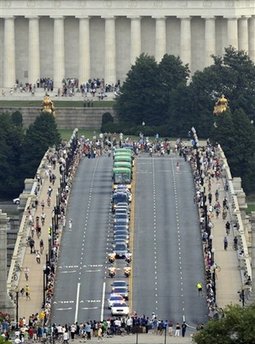
The motorcade bearing the coffin of U.S. Senator Edward Kennedy proceeds across the Memorial Bridge
on its way to Arlington National Cemetery in Arlington, Virginia, August 29, 2009.
The coffin of U.S. Senator Edward Kennedy is removed from the hearse at Arlington National Cemetery for burial in Arlington, Virginia, August 29, 2009.
The coffin of U.S. Senator Edward Kennedy is removed from the hearse at Arlington National Cemetery for burial in Arlington, Virginia, August 29, 2009
The coffin of U.S. Senator Edward Kennedy is removed from the hearse at Arlington National Cemetery for burial in Arlington, Virginia, August 29, 2009
Military pallbearers carry the casket of U.S. Senator Edward Kennedy as family members look on at the grave side during
the burial service for Senator Kennedy at Arlington National Cemetery in Arlington, Virginia, August 29, 2009.
The casket of Sen. Edward Kennedy arrives at the burial site at Arlington National Cemetery
Military pallbearers hold a flag above the casket of U.S. Senator Edward Kennedy as his wife Vicki Reggie Kennedy (R) looks on at the grave side during the burial service for U.S. Senator Edward Kennedy at Arlington National Cemetery in Arlington, Virginia, August 29, 2009
Rory and Chris Kennedy wait at the grave side for the burial services of their uncle, U.S. Senator Edward Kennedy, at Arlington National Cemetery in Arlington, Virginia, August 29, 2009
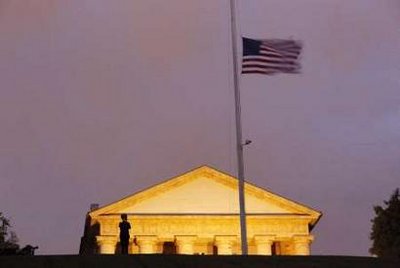
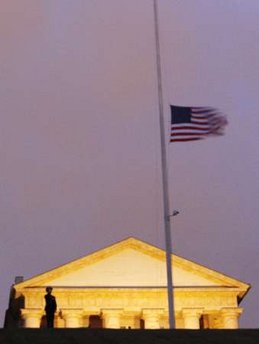
A bugler plays taps during the burial service for U.S. Senator Edward Kennedy at Arlington National Cemetery in Arlington, Virginia, August 29, 2009.
Members of the Kennedy family hug after the burial service for U.S. Senator Edward Kennedy at Arlington National Cemetery in Arlington, Virginia, August 29, 2009
Mourners gather at the coffin of Sen. Edward Kennedy at Arlington National Cemetery in Arlington, Va., Saturday, Aug. 29, 2009
Edward Kennedy III (R) cries as he places a rose on the casket of his grandfather U.S. Senator Edward Kennedy at Arlington National Cemetery in Arlington, Virginia, August 29, 2009.
Sen. Edward Kennedy's grandchildren and family members kneel over his coffin during his burial service at Arlington National Cemetery in Arlington, Va., Saturday, Aug. 29, 2009
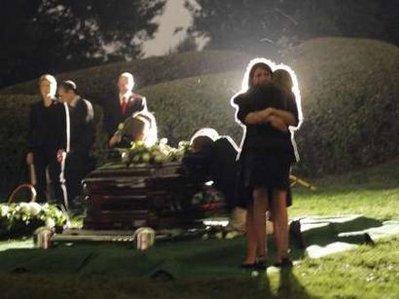
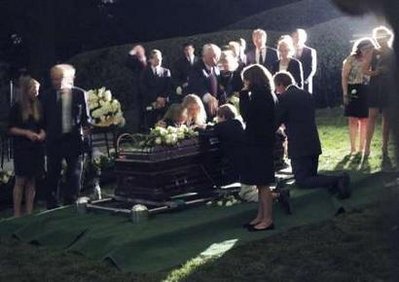
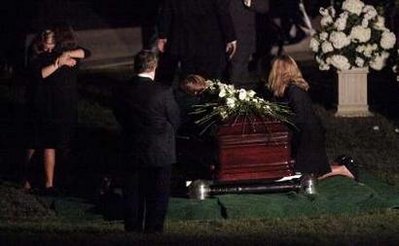
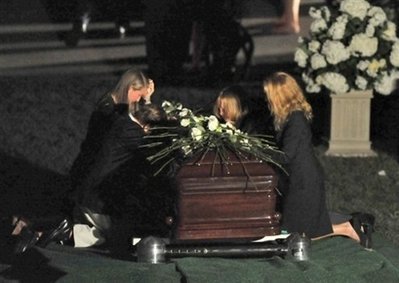
The Kennedy family gathers around the the casket of the late U.S. Senator Edward Kennedy during the burial service at Arlington National Cemetery in Arlington, Virginia, August 29, 2009
Kara Kennedy (C) stands behind the casket of her father during the burial service for U.S. Senator Edward Kennedy at Arlington National Cemetery in Arlington, Virginia, August 29, 2009
Family members gather at the coffin of Sen. Edward Kennedy at Arlington National
Cemetery in Arlington, Va., Saturday, Aug. 29, 2009
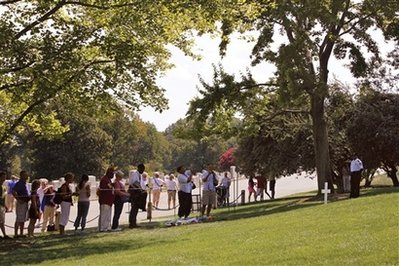
Visitors at Arlington National Cemetery line up to pay their respects to Senator Edward Kennedy at the site where he was buried late Saturday, onSunday, Aug. 30, 2009
Flowers are seen at the newly dug gravesite of the late U.S. Senator Edward Kennedy at Arlington National Cemetery, August 30, 2009
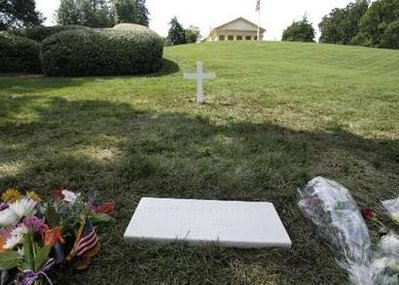
A cross and a memorial tablet are seen at the newly dug gravesite of the late U.S. Senator Edward Kennedy at Arlington National Cemetery, August 30, 2009
Michael Robert Patterson was born in Arlington and is the son of a former officer of the US Army. So it was no wonder that sooner or later his interests drew him to American history and especially to American military history. Many of his articles can be found on renowned portals like the New York Times, Washingtonpost or Wikipedia.
Reviewed by: Michael Howard

